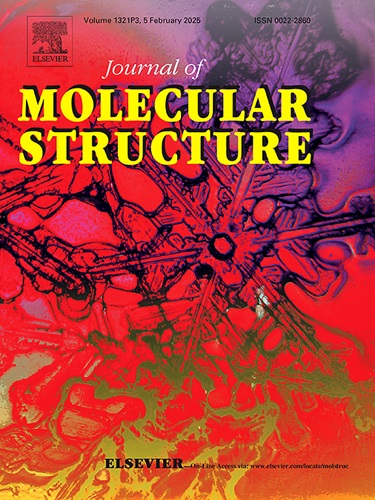HPW/SBA-15/聚苯胺纳米复合材料在超声辅助氧化脱硫过程中的异相催化剂研究:实验、统计分析和优化
IF 4
2区 化学
Q2 CHEMISTRY, PHYSICAL
引用次数: 0
摘要
以SBA-15、磷钨酸和聚苯胺(PAni)为原料,成功合成了一种新型的超声辅助氧化脱硫(UAOD)纳米复合材料HPW/SBA-15/PAni。采用XRD、UV-DRS、FE-SEM、edx元素图、TEM、FT-IR、TGA、BET-BJH等技术对样品进行表征。研究了含苯并噻吩和二苯并噻吩的正辛烷模型燃料体系。用乙腈提取氧化反应结束后产生的砜。采用Box-Behnken法设计实验,考察了反应温度(°C)、氧化剂与硫的摩尔比(mol./mol.)和催化剂/燃料(g/L)三个重要操作因素的影响。并利用响应面法(RSM)对工艺条件进行了优化。结果表明,在最佳条件下,模型燃料中BT和DBT的去除率分别为83%和92%。结果表明,硫氧化动力学符合准一级动力学模型。HPW/SBA-15/PAni催化剂可以成功重复使用5次,其催化活性没有明显下降。使用这些新的纳米催化剂,对水氧化反应中其他催化剂的设计有了有价值的见解。本文章由计算机程序翻译,如有差异,请以英文原文为准。

Investigation of HPW/SBA-15/PAni nanocomposite as a new heterogeneous catalyst in the ultrasound-assisted oxidative desulfurization process: Experimental, Statistical analysis and optimization
A novel nanocomposite, HPW/SBA-15/PAni, was successfully synthesized based on SBA-15, phosphotungstic acid, and polyaniline (PANI) for ultrasound-assisted oxidative desulfurization (UAOD) applications. The samples were characterized by XRD, UV-DRS, FE-SEM, EDX-elemental mapping, TEM, FT-IR, TGA, and BET-BJH techniques. A system of model fuel including benzothiophene and dibenzothiophene in n-octane was studied. To extract the sulfones produced at the end of the oxidation reaction, acetonitrile was used. The effect of the three important operating factors, including reaction temperature ( °C), oxidant to sulfur molar ratio (mol./mol.), and catalyst/fuel (g/L), were examined using the design of the experiment carried out by the Box-Behnken method. Additionally, the response surface methodology (RSM) was used to optimize the operating conditions. Results showed that BT and DBT removal efficiency from model fuel in optimum conditions were 83 % and 92 %. The results showed that the sulfur oxidation kinetics followed the pseudo-first-order kinetic model. The HPW/SBA-15/PAni catalyst could be reused 5 times successfully without any significant decrease in its catalytic activity. Using these new nanocatalysts, a valuable insight to the design of other catalysts in water oxidation reactions was developed.
求助全文
通过发布文献求助,成功后即可免费获取论文全文。
去求助
来源期刊

Journal of Molecular Structure
化学-物理化学
CiteScore
7.10
自引率
15.80%
发文量
2384
审稿时长
45 days
期刊介绍:
The Journal of Molecular Structure is dedicated to the publication of full-length articles and review papers, providing important new structural information on all types of chemical species including:
• Stable and unstable molecules in all types of environments (vapour, molecular beam, liquid, solution, liquid crystal, solid state, matrix-isolated, surface-absorbed etc.)
• Chemical intermediates
• Molecules in excited states
• Biological molecules
• Polymers.
The methods used may include any combination of spectroscopic and non-spectroscopic techniques, for example:
• Infrared spectroscopy (mid, far, near)
• Raman spectroscopy and non-linear Raman methods (CARS, etc.)
• Electronic absorption spectroscopy
• Optical rotatory dispersion and circular dichroism
• Fluorescence and phosphorescence techniques
• Electron spectroscopies (PES, XPS), EXAFS, etc.
• Microwave spectroscopy
• Electron diffraction
• NMR and ESR spectroscopies
• Mössbauer spectroscopy
• X-ray crystallography
• Charge Density Analyses
• Computational Studies (supplementing experimental methods)
We encourage publications combining theoretical and experimental approaches. The structural insights gained by the studies should be correlated with the properties, activity and/ or reactivity of the molecule under investigation and the relevance of this molecule and its implications should be discussed.
 求助内容:
求助内容: 应助结果提醒方式:
应助结果提醒方式:


